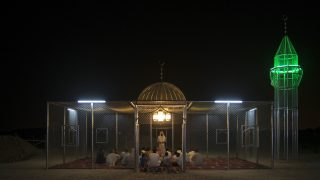Of all the prevailing models of political and economic governance that have been challenged by the popular movements of the Arab Spring, perhaps the most intriguing regime is the tribal dynasty, and modern nation state, declared by the Saud family in the Arabian Peninsula in 1932 (See Christopher M. Davidson, After the Sheikhs – the coming collapse of the Gulf Monarchies, OUP, NY, 2013). The economic “viability” of this state founded by warriors and nomadic herders, has always been rooted in its spectacular fossil-fuel wealth, which for the past century has rendered it and the other Arab tribal oil-states it surrounds in the Persian Gulf the focus of geo-political struggle and the generation of immense wealth for its rulers and elites: the so-called “prize”. Along with the other five members of the Gulf Cooperation Council (Bahrain, Kuwait, Qatar, UAE, Oman), these monarchies have survived wave after wave of Arab nationalism, republicanism, social unrest and more recently Islamisation.
To most outsiders (i.e., everybody outside the narrow inner circles of the ruling dynasty), Saudi Arabia is something of an enigma: an absolute monarchy ruling over 18 million subjects (and 9 million expatriagte workers), allowing no organized opposition to its assumed role as Guardian of Islam’s most Holy Places, sharing with its people what it deems fit from the proceeds from the nation’s natural resources,spreading its influence/wealth among nations, allies and agents in the region, and building a capitalist market economy formally integrated into the regional and global economic governance institutions, even the WTO.
Certainly, the regime’s hegemony has been challenged by internal revolts and Arab and Iranian rivalry at different stages in its history. But its bedrock of oil wealth, US strategic support and status as claimant to the “throne” of Sunni Muslim leadership, has served it well over the years and maintained the supreme influence of this Arab gerontocracy in a region today bubbling with youth revolts and calls for liberty, democracy and development. And more recently, its successful integration into global financial capital markets and networks has further strengthened its claim to legitimacy, notwithstanding the outdated and repressive form of political governance and reactionary social values that it espouses.
Saudi Arabia has always deftly leveraged its economic power within the region and beyond to advance the regime’s political agendas and national security interests ever since the international oil embargo of the 1970s, through the Iran-Iraq war and the subsequent Gulf Wars, until today’s struggles for regime change in Yemen, Egypt and Syria and beyond. Yet, for all the power that the accumulated capital of the Saudi regime represents, buttressed by the latest fighter jets, missile weaponry and security systems that money can buy, it still has to face the same global economic forces sweeping through the region as elsewhere. And like others, even oil-rich Saudi Arabia has finite resources to maintain the lavish style of life and authoritarian mode of governance to which the royal family and the ruling classes allied with it have grown accustomed.
At first glance, the overall Saudi macroeconomic policy objectives and outlook (as reported to the G20) seemreasonable, sustainable and in line with structural reform orthodoxy. With a current GDP growth rate of around 5% projected to weaken only slightly to no less than 4.4% over the next five years, reliance on export growth (of 5% annually in 2012/13) will be reduced, while an expected slackening of private consumption will be compensated through higher rates of growth of fixed investment (currently at 8% annually, but projected to remain strong at over 4% in the coming years). A gradual tightening of credit policy is expected to bring private credit growth below 10% from its current 15% per annum. The new normal of tolerable projected inflation at around 3.5% reflects a soft landing approach for an economy searching to reduce its chronic payments surplus from 23% of GDP in 2012 to 11% (and trade surplus from 35% to 21%) within five years.
While economic diversification, shifting to stimulating domestic aggregate demand and labour market reform are at the top of the Saudi policy making agenda, the temptation to rely on the resource curse/blessing and an assumption of crude oil prices averaging $100/b in the medium term is one that the ruling elites and the population at large have not appeared especially motivated to resist. And with FDI and other investment flows anticipated to generate a net international investment surplus of around $120bn by 2016, from the top of the pyramid at least, the prospects for this industrializing and financializing economy seem stable and promising on the surface.
But this particular Middle Eastern model of state capitalism carries within its apparent stability a range of contradictions, between labour and capital, between haves and have-nots, between national and expatriate labour and between young and old that risk creating unmanageable fissures within this monolithic regime. Whereas other authoritarian economic governance models exhibit flexibility and planning for fundamental change as market forces are gradually liberalized (eg. China or Russia), Saudi Arabia’s efforts to address growing internal and external pressures have yet to reveal an appreciation of how much must change if the state and the regime is to survive intact. If anything, economic policies in the past few years have exacerbated real divides in the society and economy and failed to offer sustainable remedies for the inherent weaknesses of the autocratic governance model that has been the secret to its success.
***
Part II
However promising they may be, aggregate indicators mask the same challenge as faced elsewhere in the region of productively employing a growing, youthful labour force and reducing unemployment rates, which are stuck above 10% but which official forecasts’wishful thinking puts at only 5% (helping to produce the preceding rosy projection scenario). This significant supply side bottleneck is further complicated by the extraordinary reliance of the Arab Gulf economies in general, and Saudi Arabia especially, on a complex system of what Adam Hanieh has referred to as the “spatial structuring of class” that is a “type of class formation that links the development of social relations across different spaces in the region” (Lineages of revolt, p 126). This has entailed a highly regulated import and exploitation of mainly low paid, migrant Asian (and Arab) workers in often wretched conditions, to provide the bulk of the labourthat Arab Gulf capital has needed in order to expand and deepen and reproduce the ruling elite, generation after generation, one capitalist strata upon the other. Recent downward “adjustments” have been enforced on the total migrant labour supply that Saudia Arabia is willing to tolerate (which reached as much as 9 million) at a moment when “Saudisation” of the work force is a top policy priority. This led to the mass deportations of two million Asian and African undocumented and other migrant workers in 2013, and untold misery for 120,000 Ethiopians in particular, who were subject to especially racist treatment and brutally transported home (Vijay Prashad, “Contract Slavery” in Frontline, 23 December 2013).
Only under the autocratic, indeed idiosyncratic, governance model of the Saud family and its well-woven marriage of the interests of the state and the increasingly empowered capitalist-financial classes could such a primitive labourexploitation system be permitted to exist in the 21st century. And only with the ability to resort to such a “spatial structuring of class” and an economic model that allows for maximum retention and political distribution of rents and related privileges that powers this particular form of Arab state capitalism, can these last remaining absolute monarchical states in the region (and in the world) hope to survive.But how sustainable is such a political and economic system, and to what extent do other authoritarian paths to state capitalism offer lessons that perhaps Saudi Arabia could benefit from if there is ever to be a peaceful transition from autocracy to democracy?
Conventional wisdom would have it that technocratic structural adjustment and reform of the inadequate regulatory framework holds hope for making Saudi Arabia’s labour market and economy more productive, inclusive and competitive. The government is formally committed to significant new expenditures on the social sectors and infrastructure, introducing new social safety net measures, as well as creating job opportunities for the youth, and meeting demand needs for housing, all the while pursuing accommodative monetary policy appropriate to the evolving macroeconomic conditions.
As for another primary Saudi policy goal, namely improved incentives in the labor market, a recent report by the ILO, for example (ILO, April 2013, “Tricked and Trapped: Human Trafficking in the Middle East”), advocates for reforms that have little bearing on the political realities of the monolithic Saudi system. As Vijay Prashaddrily points out “The ILO makes several recommendations that are likely to be ignored—reform the kafala system, bring all workers under the protection of domestic labour laws, increase the power of labour inspectorates for worksite monitoring, and build up worker organisations”. While admittedly the ILO would not wish to advocate for political revolution, even their timid, mainstream formulae actually would require real regime change were they to be seriously pursued.
The Saudi state’s capitalist model may have been shaken by the prospect of social change from below stalking the region, and the alarmed tones emitting from ILO and human rights organisations regarding the incompatibility of this economic governance mode with global rights and standards are telling in themselves. But like other entrenched autocratic regimes in the region faced with grave socio-economic challenges(the revival of the pre-2011 Egyptian ruling classes is yet another example), Saudi policy makers have no option (nor imagination) but to revert to the sort of policy stance that fits with IMF and related orthodoxy, and hope for the best.
They simply cannot contemplate the sort of political and social transformations that have to accompany the capitalist transformation underway if it is to succeed in its own terms, despite its many unresolved internal conflicts. The Chinese road to (and from) socialism, and now to a form of state capitalism, which ensured, or at least promoted, a long term reduction of poverty, improved living conditions and opportunity for the broad masses of working and peasant classes, while building a powerful, modern and gradually liberalizing economy. However, the Saudi road to a hybrid mode of Arab state and financial capitalism has been geared largely to ensuring the enrichment and perpetual rule and wide-ranging influence of a number of Arabiantribal families in the name of Sunni Islam and the Arabs, while subsuming economic development to the lowest rungs of policy concern. Authoritarianism in China continues to cede way to pluralism and globalized consumers, and its one-party state has been more adept in power sharing than the Saudi ruling family. The latter can only resort to allowing a gradual and selective penetration of globalization into Saudi society, while practicing stern repression of any form of political, social or artistic expression, allsanctioned by an obscure strand of medieval conservative Islamist (Wahhabi) religious doctrine.
No doubt, the Saudi regime doesn’t stand alone in the face of its people or the Arab peoples’ desire for liberty and democratic governance. Its geo-strategic value to the West and Israel, as well as its strong integration into global capital and finance networks, with a seat at the G20 table, will serve it well in weathering the economic and political challenges that lay ahead. The imminent overthrow of these regimes has been on the agenda of many Arab nationalists, revolutionaries and pundits since the 1960s at least and yet these regimes have only grown stronger over the decades. However it is also arguable that they have never faced quite the same potent mixture of rapid social transformation and protest, economic inequality and youthful political yearning that remains omnipresent. Even if the unresolved contradictions between Arab capital, labour and class can be relegated to the background of the sectarian strife being fuelled from Iraq to Syria and Lebanon amidst a supposed resurgence of the historic Sunni-Shiite schism, they will remain decisive dynamics within the coming conflicts in the region.
Translated by Assafir - Arabi






